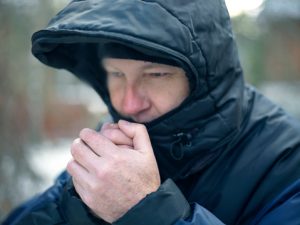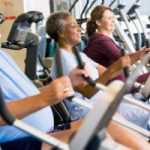 7Cold hands and cold feet could be a sign of circulation problems, especially when they occur along with tingling and numbness. Plenty of people suffer from such circulation problems, whether they’re relatively minor, more severe or potentially life-threatening. That’s because cold temperatures make blood vessels in the hands and feet constrict, diverting blood toward some of the more vital organs. Your poor extremities feel the brunt of it.
7Cold hands and cold feet could be a sign of circulation problems, especially when they occur along with tingling and numbness. Plenty of people suffer from such circulation problems, whether they’re relatively minor, more severe or potentially life-threatening. That’s because cold temperatures make blood vessels in the hands and feet constrict, diverting blood toward some of the more vital organs. Your poor extremities feel the brunt of it.
A condition called peripheral vascular disease – or PVD – can also narrow the arteries that supply blood to the legs. In its mildest form, the disease can cause poor circulation and cold feet.
Advertisement
What’s surprising, though, is that few people know how to improve their circulation or prevent damage to their circulatory system. Fortunately, improving your circulation is a relatively easy thing to do. It requires us to reverse the very things that we’re doing wrong – things leading to poor circulation in the first place.
4 tips to help improve circulation in hands and feet
Here are 4 solutions for your perpetually cold hands and feet.
1. Exercise
Simply put, physical activity keeps your heart healthy. Even a little bit of exercise every single day – at least three or four times per week – can greatly improve your circulation, not to mention keep you in great shape.
A higher volume of blood moves more rapidly through your arteries and veins whenever your heart muscle contracts at a faster rate. This causes a boost in your overall circulation.
At first, try cardio activities, such as walking, before attempting a light jog. Swimming is highly effective, too, especially for anyone with knee and joint problems.
2. Stop smoking
It’s true that it may take a while and plenty of commitment, but once you stop puffing, your body will begin to repair itself, undoing all of the bad stuff cigarettes did to your circulation.
Smoking happens to be a key risk factor for peripheral artery disease (PAD) – or poor circulation in the legs.
It’s not a pretty picture. Whenever you smoke, toxins from the smoke enter your bloodstream and: make your blood thicker and increase the likelihood of clot formation, raise your blood pressure and heart rate, cause your heart to work harder than usual, and narrow your arteries, reducing the amount of oxygen-rich blood circulating to your organs. And all of these can lead to an eventual heart attack or stroke.
3. Massage
When it comes to cold fingertips and toes, massaging your hands and feet will get your blood flowing directly to your extremities, warming them up. Although it’s not a cure, or even a permanent solution, this technique can go a long way in improving your blood circulation.
Generally, a healthy circulation brings oxygen-rich blood to tense and damaged muscles. A massage facilitates that circulation because the pressure created by a particular massage technique actually transfers blood throughout congested areas. The release of this same pressure then causes new blood to flow in.
What’s more, a massage helps to relax the muscles in your back and loosen some of those that are bothered by the sciatic nerve, which extends from the lower end of your spinal cord all the way down the back of your thigh, dividing above the knee joint. So if you suffer from chronic sciatic discomfort, for example, massage can help.
4. Change your diet
By replacing what you eat, you can improve your circulation immensely. Instead of eating processed food – basically, those high in salt, fat and sugar – try adopting a diet of complex carbohydrates. That means things like whole-wheat breads, oat bran, brown rice, baked beans and edible-podded peas.
And remember PVD? Well, recent studies have concluded that the vascular disease is associated with low levels of vitamin C in the body. So consider getting more vitamin C from fruits and vegetables, such as bell peppers, kale, Brussels sprouts, kiwi and guavas.
Yet another nutrient that may help is vitamin E, which can thin the blood so it can pass more efficiently through narrowed vessels. Consume more vitamin E from foods that contain some fat, such as seeds, nuts, avocado and wheat germ.
When it comes to improving your circulation, there are steps you can take, so don’t suffer with the cold that can lead to more aches, pains and joint stiffness. Good circulation is a sign of good health.
The following are some tips to help improve blood circulation:
- Wear warm clothes: It is important to dress for the weather. Wearing a warm sweater, coat, or other types of warm clothing is a must when going out into cold weather. This will help to retain body heat and make you feel more comfortable while being outdoors.
- Be active while outdoors: Standing still can impede adequate blood circulation. By moving around during times of being idle, such as waiting for a friend or a bus, simply taking a few steps back and forth will be sufficient. Getting the blood moving will also help maintain body temperature.
- Drink hot drinks: While being safe not to burn yourself, drinking a hot drink can be great during cold times of the years. Whether it’s coffee, hot chocolate, or tea, warm drinks help keep your body warm.
- Do not put frosty hands directly to a heat source: Despite the desire to warm up your hands as fast as possible, it is not advisable to place very cold hands on to a heat source right away. Instead place them close to the heat source to absorb the heat from a short distance. Also, you can wash your hand under some warm and rub your hands together to maximize circulation.
- Every morning, drink 150 ml of red wine: This can help improve blood circulation while additionally offering many health benefits as well. However, it is advised not to go over this limit and not to start drinking for the sake of promoting blood circulation.
- Warm up your feet: Located at the bottom of your body, your feet are the last to receive adequate blood circulation. To help give your feet the best chances to receive blood, you can try to keep them warm, as well as consume foods such as fish oil and ginger, which are known to promote blood circulation. Also, it is beneficial to reduce to amount of caffeine you consume as this can constrict blood vessel and reduce circulation.
With these tips, you’ll have a far clearer mind and lots of energy. Of course, your hands and feet will feel much warmer, too.
Related Reading:
Advertisement
Indoor winter allergy risks, stopping asthma, rhinitis causing allergens in your home
The risk of winter allergies can be lowered by preventing the allergens that cause asthma and rhinitis. Although the springtime is more commonly known to produce allergens, the winter can also generate allergens. Continue reading…
Is the winter season the cause of your low energy?
There are two types of people in the world: those who love winter and those who hate it. There is a very long list of pros and cons for winter, but when it comes to the cold and snow, people usually aren’t on the fence about their feelings. Continue reading…
Sources:
http://news.health.com/2014/12/25/why-your-hands-and-feet-are-always-cold-and-what-to-do-about-it/
